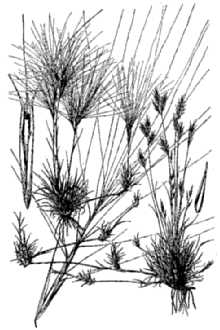Burrograss
Scientific Name: Scleropogon brevifolius Phil.

| General Information | |
|---|---|
| Usda Symbol | SCBR2 |
| Group | Monocot |
| Life Cycle | Perennial |
| Growth Habits | Graminoid |
| Native Locations | SCBR2 |
Plant Guide
Use soil moisture sensors to measure the soil moisture of Burrograss.
Fact Sheet
Alternate Names
burro grass
Uses
Burrograss is grazed by cattle, horses, and sheep.
Status
Please consult the PLANTS Web site and your State Department of Natural Resources for this plant’s current status, such as, state noxious status, and wetland indicator values.
Description
Grass Family (Poaceae). Burrograss is a native, warm-season, weak, stoloniferous perennial. The height ranges from 4 to 8 inches. The leaf blade is flat and narrow with sharp pointed leaves. The leaf sheath is rounded, shorter than internodes, and mostly basal. Seedheads have a raceme inflorescence, staminate (male) spikelets, awnless pistillate (female) spikelets, and numerous long awns. Distribution: For current distribution, please consult the Plant Profile page for this species on the PLANTS Web site.
Management
Cattle and horses seldom overgraze this grass, because it grows so close to the ground. Sheep can graze it close enough to kill it. Sheep should graze this grass only in spring before the seed matures and in the late fall and winter after seed dissemination to prevent awns from collecting in their wool and causing eye irritation.
Establishment
Growth starts in May or June and the seedheads appear 3 to 4 weeks later, Use soil moisture sensors to measure the soil moisture of Burrograss., Burrograss is a low forage producer, It reproduces from seed and from stolons, Generally it grows in pure stands, Because it is shallowly rooted, this grass cannot compete with taller, deeper-rooted grasses, Mature female spikelets with awns break off and form tumbleweeds that are moved around by the wind, It grows on calcareous clay and clay loam soils, Cultivars, Improved and Selected Materials (and area of origin) Please contact your local NRCS Field Office,


